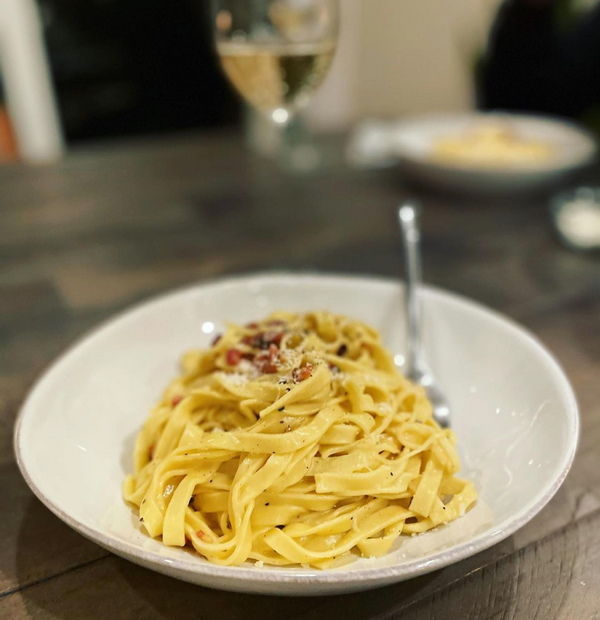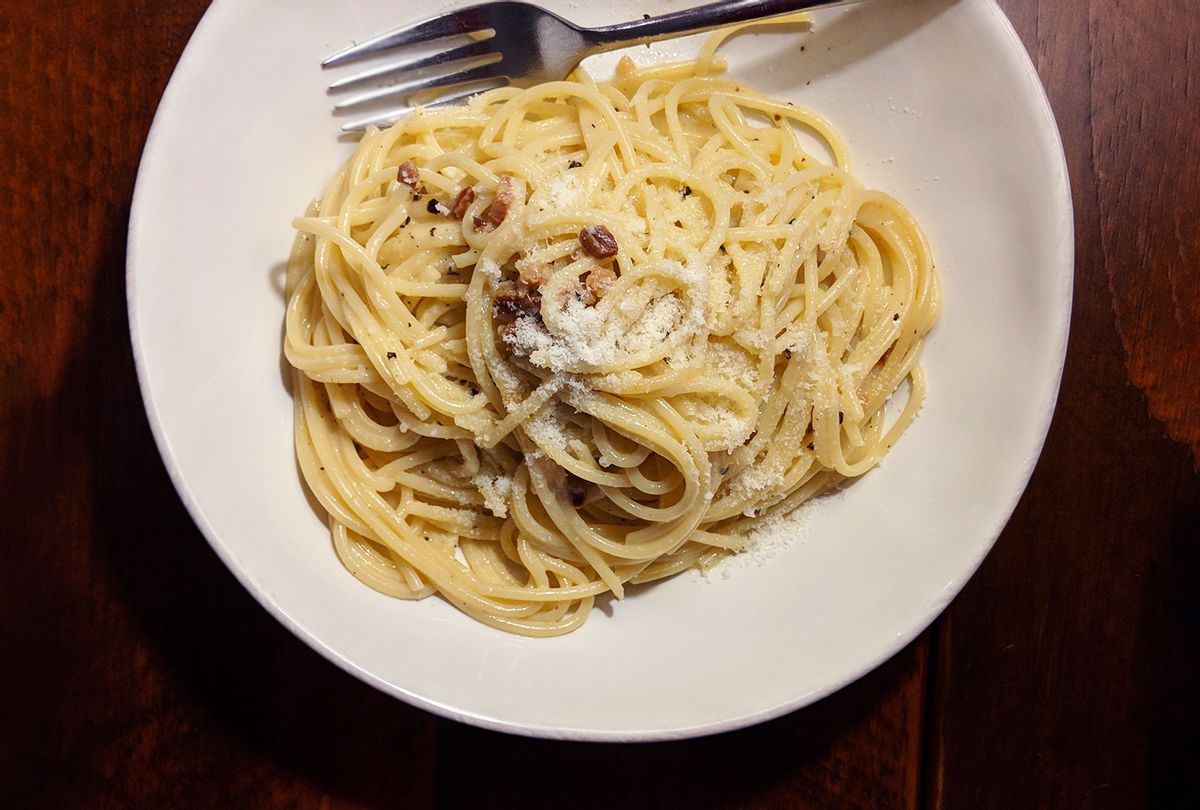I've only been to Italy once, and I cooked only a single meal while I was there. On New Year's Eve in Florence, my companions and I ventured to the historic, bilevel Mercato Centrale food market with a plan to make dinner in our little brick-walled apartment.
Everything tasted annoyingly better, just like they all said it would. The purple-speckled artichokes were earthy and delicately crunchy enough to shave raw into a salad. We dressed them with spicy olive oil and the sweet, intensely perfumed juice of thick-skinned lemons. I grew surly biting into the meaty, oily Mediterranean sardines we seared with garlic and showered with olive oil-fried breadcrumbs. By the time we were tucking into the toothsome 19-minute pici pasta with fresh fennel sausage — dressed solely with chopped tomato and a few ladlesful of surreally viscous pasta water — I'd regressed to full-on insolence.
"What's the point of cooking pasta back home ever again?" I moaned between sips of the best brunello di montalcino I'd ever tasted, which we'd bought for maybe 20 euros at a corner store.
Of course, I wasn't back from the trip two days before I cooked pasta again: carbonara, to be exact, a dish that's punctuated my weekly cooking repertoire for more than a decade. This six-ingredient pasta hails from Rome, where, incidentally, I've never been. But its luxurious simplicity — toothsome pasta, salty cured pork cubes, sharp grated cheese and cracked pepper bound with glistening egg sauce — has haunted me since I first tasted it at a fine-dining Italian restaurant in Chicago as a young culinary student.

Maggie Hennessy and her sister (Madeline Shea, left) at the Mercato Centrale in Florence. (Photo by Tom Gallagher/Eleven 9 Studio)
The first time I made carbonara, it scrambled, an occurrence that soon became so commonplace that it lost all distinction. But over time, I unriddled the method: Start with room-temperature eggs whisked together with the grated cheese, then slowly temper them with a few spoonfuls of pasta water. Choose the right pasta shape to capture that glossy sauce (ahem, bucatini!), and cook it to just al dente. Then, toss it in the warm, peppery pork fat before adding the egg mixture. To this day, nothing in my cooking life surpasses the frenzied exuberance of the method's final 30 seconds, when each component comes together with tongs and a secular prayer.
Because my first taste of carbonara was so cheffy, my early experiments came with absurdly high price tags as I sought those same elusive ingredients, from imported guanciale to duck eggs to $9 bucatini. Ingredient abasement is a dangerous business for home cooks; we face enough obstacles to getting dinner on the table. And while I'll stop short of using desiccated parmesan from a can, I've made plenty of tasty carbonara using convenience-store bacon and eggs.
Perhaps most excitingly, those of us long enamored with Italians' hyper-regional approach to cooking can now replicate carbonara more authentically than ever, thanks to the resurgence of small, sustainable American farms raising heritage pigs and free-roaming chickens and cows, and the family-run dairies producing award-winning cheeses from California to Wisconsin to Vermont. I recently made a batch using all-Midwestern ingredients, except for the peppercorns: Illinois eggs, bacon from Iowa duroc pigs, Wisconsin parmesan and romano and fresh tagliatelle from my favorite Chicago pasta restaurant — which might never have sold its handmade noodles for retail if not for COVID-19.
It was the shortest collective distance those six simple ingredients had ever traveled, yielding the best-tasting and, arguably, most Italian carbonara I'd ever made. And to think it only took 10 years.
Of course, carbonara still likes to scramble on me from time to time just to keep me humble. Fortunately, scrambled-egg-and-bacon pasta tastes delicious, too.
***

Photo courtesy Maggie Hennessy
If you're able to source any of these already-glorious ingredients from small, humane producers near your home, this dish will taste even better. I like to precede this rich dish with a sharp, bright salad dressed in lemon vinaigrette.
Recipe: Carbonara
Serves: 3 hungry people
Ingredients:
- 1/3 lb. thick-cut pancetta, guanciale or bacon, cut in 1/2-inch dice
- 3/4 teaspoon coarsely ground black pepper, plus more as needed
- 1 whole egg plus 2 egg yolks, room temperature
- 1/2 cup, plus 2 teaspoons freshly grated pecorino romano cheese
- 1/2 cup, plus 2 teaspoons freshly grated parmesan cheese
- 1 lb. bucatini or spaghetti
Method:
Place the pancetta or bacon in a cold, wide, heavy-bottomed pot. (I use a braising dutch oven or big cast-iron skillet.) Turn the heat to medium, and cook, stirring frequently, until it has rendered a good deal of fat and started to brown, 8 to 10 minutes. Turn off the heat, and grind in about 3/4 teaspoon coarse black pepper.
Crack the whole egg into a liquid measuring cup, and add the 2 yolks, beating together until well combined. In a small bowl, mix the grated cheeses together, and add 1 cup of the cheeses to the measuring cup. Whisk again, until the mixture is well combined. Set aside.
Meanwhile, heat a large pot of generously salted water. (It should taste like the sea.) Add the pasta, and cook until just al dente. When you're a minute or two shy of that point, turn the heat back on low beneath the rendered pork until it starts sizzling.
Scoop about 1/3 cup of starchy water from the pasta pot, and reserve. Using tongs, add the cooked pasta directly to the pan with the pancetta, along with a few tablespoons of the pasta water, tossing to coat it evenly with the fat. Turn off the heat.
Note: This last part goes fast! Recruit a sous chef!
Slowly stream the reserved pasta water into the measuring cup with the egg-and-cheese mixture, whisking furiously. (This will temper the eggs so they don't scramble upon hitting the pasta.) Then, immediately pour the tempered egg-and-cheese sauce into the pasta, tossing frenziedly the whole time to coat each noodle in the sauce. Add a few more grinds of pepper and another sprinkling of cheese, and toss again. Taste, and adjust as needed with cheese and pepper.
Divvy up the pasta among three large shallow bowls*, top with the rest of the cheese and a fresh grinding of pepper. Serve (and eat!) immediately.
*Chef's Note: For this and most pasta dishes I make, I like to warm the bowls beforehand by stacking them on the back burner of the stove (behind the pasta pot, off the heat) and rotating them every few minutes the whole time I'm cooking. If your bowls are oven-safe, you can also warm them on the lowest setting for a few minutes before dinner.
More by this author:



Shares